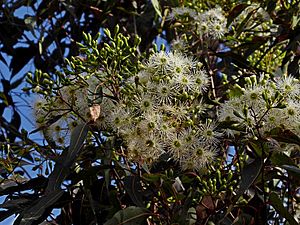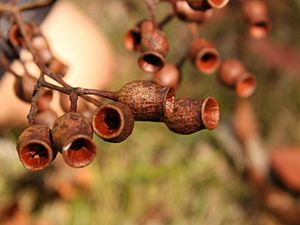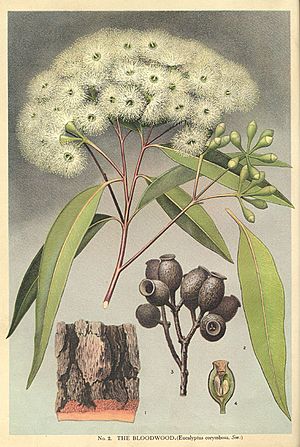Red bloodwood facts for kids
Quick facts for kids Red bloodwood |
|
|---|---|
 |
|
| Scientific classification | |
| Genus: |
Corymbia
|
| Species: |
gummifera
|
| Synonyms | |
|
Synonyms
Eucalyptus corymbosa Sm.
Eucalyptus corymbosa Sm. var. corymbosa Eucalyptus corymbosus Cav. Orthographical variant orth. var.]] Eucalyptus gummifera (Sol. ex Gaertn.) Hochr. Eucalyptus gummifera (Sol. ex Gaertn.) Hochr. var. gummifera Eucalyptus longifolia Maiden nom. inval., pro syn. Eucalyptus oppositifolia Desf. nom. inval., nom. nud. Eucalyptus purpurascens var. petiolaris DC. Metrosideros gummifera Sol. ex Gaertn. |
|
The Corymbia gummifera, often called red bloodwood, is a type of tree found only in eastern Australia. It has rough, puzzle-piece-like bark on its trunk and branches. Its adult leaves are shaped like a spear. The tree produces creamy white flowers, which grow in groups of seven, and its fruit looks like an urn.
Contents
What the Red Bloodwood Looks Like
The red bloodwood is usually a tall tree, growing about 20 to 35 meters (65 to 115 feet) high. It has a special woody swelling at its base called a lignotuber. This helps the tree regrow if it gets damaged by fire.
Young plants and new shoots have leaves that are lighter on their underside. These leaves are egg-shaped to spear-shaped. They are about 9 to 16.5 centimeters (3.5 to 6.5 inches) long and 3 to 5.2 centimeters (1.2 to 2 inches) wide. They also have a stalk connecting them to the stem.
Adult leaves are shiny and dark green on top, but paler underneath. They are spear-shaped, measuring about 5.5 to 16 centimeters (2 to 6 inches) long and 1.5 to 5 centimeters (0.6 to 2 inches) wide. These leaves have a stalk that is about 0.8 to 2.3 centimeters (0.3 to 0.9 inches) long.
The tree's flower buds grow in groups of seven at the ends of its branches. Each group of seven buds is on a main stalk, and each individual bud has its own small stalk. The mature buds are oval or pear-shaped. They are about 8 to 12 millimeters (0.3 to 0.5 inches) long and 4 to 6 millimeters (0.16 to 0.24 inches) wide. They have a cap that can be cone-shaped or rounded.
Red bloodwood trees bloom from December to June. Their flowers are a creamy white color. After flowering, the tree produces woody, urn-shaped fruits. These fruits are about 1.2 to 2.2 centimeters (0.5 to 0.9 inches) long and 0.9 to 1.8 centimeters (0.35 to 0.7 inches) wide. The seed capsules are deeply hidden inside the fruit.
How the Red Bloodwood Got Its Name
The red bloodwood was first officially described in 1788 by a scientist named Joseph Gaertner. He called it Metrosideros gummifera. He published this description in his book, De Fructibus et Seminibus Plantarum.
Over the years, this tree had several other names that are now considered incorrect or outdated. For example, James Edward Smith called it Eucalyptus corymbosa in 1795. Another scientist, Cavanilles, used a similar name, Eucalyptus corymbosus, in 1797.
In 1995, two botanists, Ken Hill and Lawrie Johnson, changed the tree's name to Corymbia gummifera. This is the name we use today.
Where the Red Bloodwood Lives
The red bloodwood tree mostly grows along the coast of eastern Australia. You can find it from the far eastern part of Victoria, up through New South Wales, and into south-eastern Queensland. It grows best in moist, rich, loamy soil. However, it can also be found in poorer, sandy soils.
Uses of the Red Bloodwood
The inner wood, called heartwood, of the red bloodwood is very strong and lasts a long time. However, it often has many lines of gum within it. Because of its strength, this wood is used for rough building projects. This includes things like poles, railway sleepers, fences, and timber for mining.
Sometimes, the red bloodwood is also used as a rootstock. This means it provides the root system for another type of tree, the beautiful Corymbia ficifolia, which is then grafted onto it.
See also
 In Spanish: Palo de sangre rojo para niños
In Spanish: Palo de sangre rojo para niños




